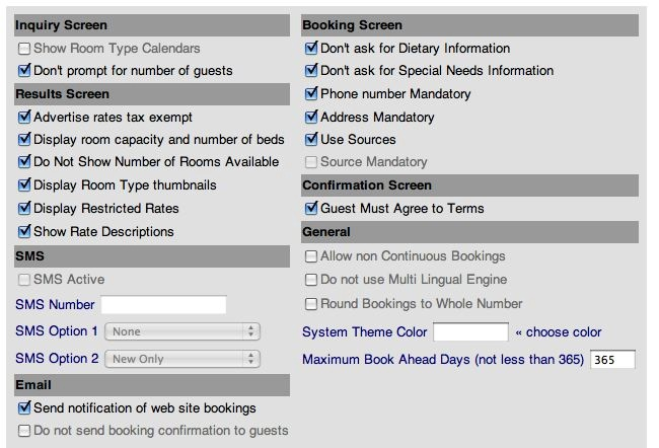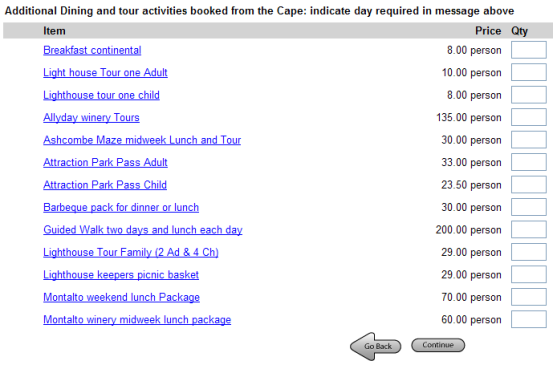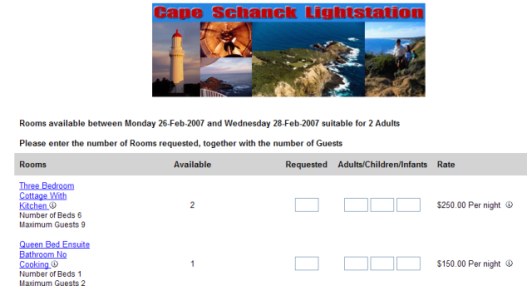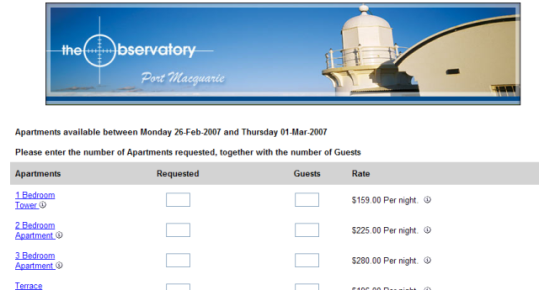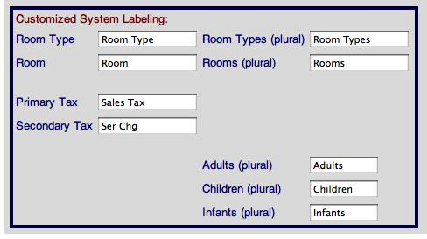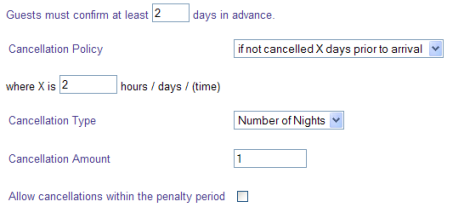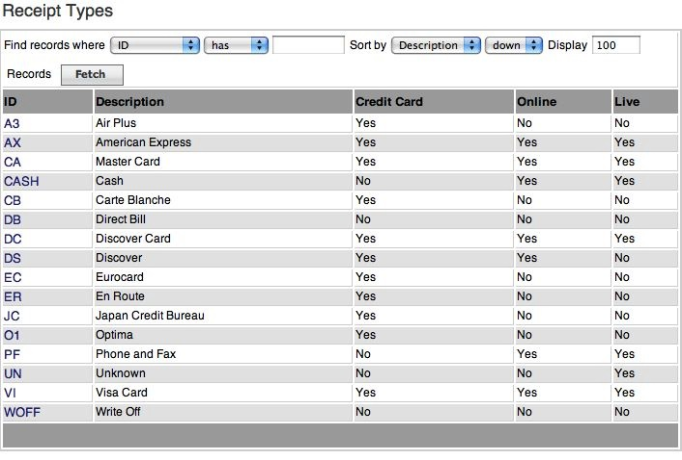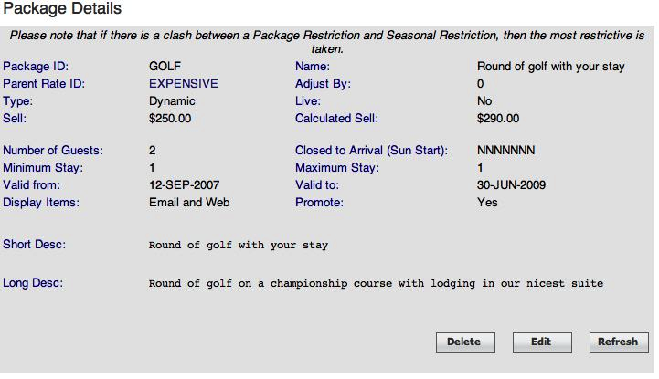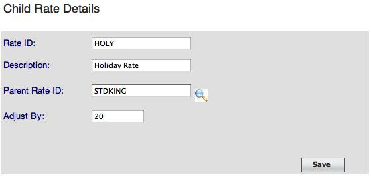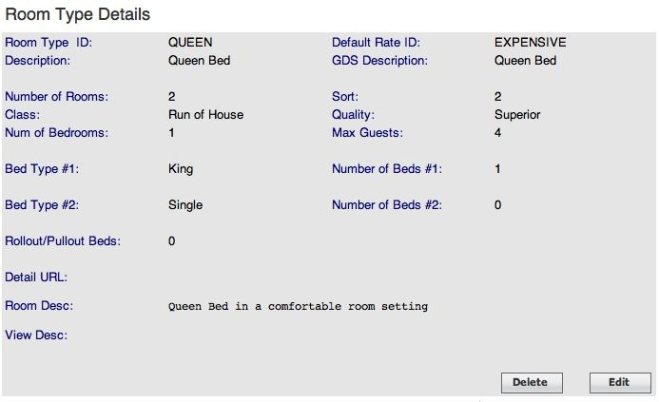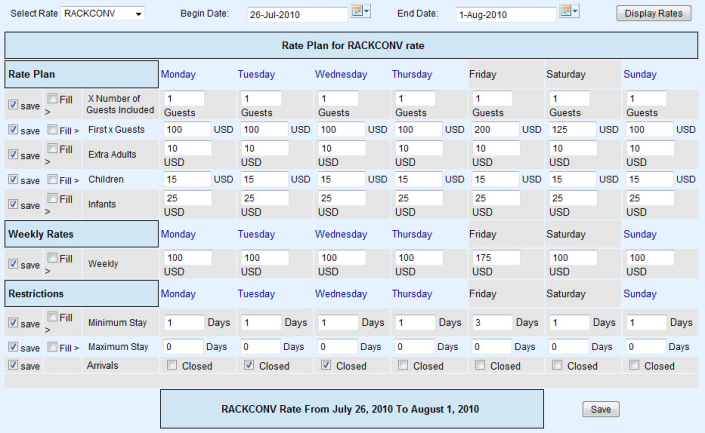- Advertise rates tax exempt - if your property is tax exempt tick this box.
- Display room capacity and number of beds on results page – displays under each available room on the results screen - helpful information.
- Do Not Show Number of Rooms Availability – on the results screen, there is a column that will display the number of available rooms for ach room type. Some properties want to prefer to hide this information.
- Display Room Type Thumbnails – Displays a small thumbnail image of the room type on the results page.
- Display Restricted Rates – if you wish to show restricted rates with an explanation of the restriction – such as a minimum stay or maximum stay – then select this. If not checked, then only bookable rates will show on your Booking Engine requests. It is recommended to always have this option turned on so the guest receives a message like: This rate plan requires a two night minimum to book.
- Show Rate descriptions – This displays the rate description in addition to the rate value. Example: Spa Package rate : $220.00 per night
SMS
- SMS Active – Tick this box if you want to activate SMS. This will send a special message to the operator. There is a set-up fee, monthly fees and a per message fee to receive SMS booking confirmations. Please ring +1-707-847-3922 ext.201 for a quote.
- Send notification of website bookings - Tick this box to receive e-mail notification of bookings. (Highly recommended).
- Do not send booking confirmation to guests - Tick this box if you if you prefer to send manually generated confirmations to guests.
Booking Screen
- Don't ask for Dietary Information – if you serve meals and need to know preferences then tick this box.
- Don't ask for Special Needs Information – if you want guests to indicate special needs tick this box.
- Phone number Mandatory – if you require a phone number with every booking tick this box.
- Address Mandatory - if you require an address with every booking tick this box.
- Use Sources – Tick this box if you want to turn on the ability for guest to select where they heard about your property.
- Source mandatory – Tick this box if you want to make it a requirement that the guest selects where they heard about your property.
Confirmation Screen
- Guest Must Agree to Terms – some people would suggest that the terms and conditions at the time of booking are a binding agreement, but in reality we all know this must be tested on a case by case basis. Still, requiring the guest to tick a box to agree to your terms may help you in case of disputes.
General
- Do not use Multi Lingual Engine – Tick this box if you want to turn off the multi lingual functionality of the booking engine.
- Round Bookings to Whole Number – tick this box to round bookings
- System Theme Color - Changes the background colors of the Enquiry screens used by guests to make bookings. Select from the picker or place in your HEX values.
- Maximum Book Ahead days - Place a value in this box to allow guest to book x number of days in the future – note, this does not affect GDS and Global Booking Network sites, they can always book 365 days in advance, so place rates for at least these many days if distributing to them.
Typical Selections
Notification of Bookings
Remember every new booking will debit availability for future bookings. In addition, the system can send the property notification of bookings by e-mail or SMS. You also have the option to send an automated booking confirmation to the guest.
Online Items Header
To Sell Items with bookings, you must purchase the Point of Sale module. Items are displayed for sale during the booking. For example, you may want to sell tours and services with a booking. Items will allow you to upload pictures and descriptions for Items.
There are no commissions on the value of Item sales, but you must pay a one-time fee to use this feature. If you do not use this feature ignore the box titled Online Items Header. If you do use this feature, enter the Header that will display above your Inventory Items.
Example for Cape Schanck Lightstation - http://requests.bookingcenter.com/enquiry.phtml?site=SHANCK
Web Tracking Code
This section is for users of the MSO Marketing Services Organization. Since Google and other 'trackers' also have nice features available in their tracking products - FOR FREE - many of our customers use their system. See: our MSO Help Page for specifics on how to use these features. Note, the final code for 'Web Tracking Code Last Page' is used by BookingCenter's Booking Engine posts the Total Cost and Booking ID values to Google Analystics in order to use the 'Campaign Conversion' features built into Google Analytics. In order to get support for setting up Google Analytics and Campaign Conversions, customers need to work with their webmaster - it's not a service BookingCenter provides. For customers who wish to track the 'Campaign Conversion' features built into Google Analytics, the key parts are the 2 variables BookingCenter sends upon the completion of the booking. These are:
- %%$booking_id%% - This is the Booking ID. If there were multiple rooms booked in a single transaction, then this is the 'root Booking ID'. For example, if three rooms were booked and the Booking IDs were = 12345-1W, 12345-2W, and 12345-2W, the %%$booking_id%% wil be "12345".
- %%$total_price%% - This is the total cost. This might include Inventory Items and Packages Items if you sold that in the transaction, so consider that when analyzing your results - the %%$total_price%% is NOT room costs only.
These variables must go in exactly as is (including using the %% values in front and behind the database variables), otherwise this won't work.
Here is a sample of the Google script:
<script type="text/javascript">
var pageTracker = _gat._getTracker("UA-12345-1");
pageTracker._trackPageview();
pageTracker._addTrans("%%$booking_id%%");
pageTracker._addItem("1", "%%$total_price%%", "1" );
pageTracker._trackTrans();
</script>
For additional help, view the MSO Help Page for specifics. Customized Enquiry System Labelling:
Please change the labels to suit your property, i.e., Suites, Cabins, Camp sites, Beds, etc. If your tax is called T.O.C. for example, change the label.
There are 3 fields on the booking form that are often labelled – 'Adults', 'Children' and 'Infants'. The first label (Adults) must be used. The 2nd (Children) and 3rd (Infants) labels are optional. Many properties switch off the 2nd and 3rd label and change the first label to Guests. If that is your preference, change the field for Adults to "Guests" and go back No Children and No Infants in General Settings and tick the boxes "No Children Allowed" and "No Infants Allowed".
Examples – Cape Schanck Lightstation - Adults, Children and Infants
Example - The Observatory in Port Macquarie - Guests
This section allows the property to customizes the labelling within the program
-
- Be sure to Click Update to save your changes!*
Multi Lingual Booking Engine
The ability to show your international guests the online booking system in 'their language' is enabled by UN-checking the feature "Do not use Multi Lingual Engine ". By default, the multi lingual feature is switched off for you, and defaults to US English.
If the multi lingual engine is on, the system uses a Geoip lookup to try to work out the country the browser is coming from. It then looks up the Country to determine the default language for that country. We also use this Geoip lookup to get a default time zone for the Country, which helps with an issue, for example, where it is "tomorrow in Australia" when it is 'today' where the servers reside in North America. The supported languages include Spanish, Italian, French, and German, but new languages are being added all the time. If you desire an additional language, and can help translate the terms of the 'Booking Engine', email info@BookingCenter.com and we will send you a template to translate. Marketing And Policies
Terms for Advance Payments
The Online Booking system gives you a secure facility to collect credit cards. The Online Booking system can process credit cards, but you must have purchased the POS Module in order to do so. Contact BookingCenter at +1-707-874-3922 ext. 201 for purchase help setting up automatic credit card collections. If you do not have the POS Module, processing Credit Cards is a manual step performed by the property. When a guest provides you with credit card details, you must process their cards like a 'phone order' based on your 'Deposit, Confirmation, and Cancellation Policy Message'.
Options - "No Deposit", "1-night deposit", or "a percentage deposit" (set the percentage). "A credit card guarantee" is not a legally binding commitment in most cases.
Advance Payment Terms for GDS enabled Properties
If you do not use the GDS, skip to 'Deposit, Confirmation, and Cancellation Policy Message'
Deposit, Confirmation, and Cancellation Policy Message – explain in 'your own words' policies for advance deposits, conditions for cancellations and refunds and any special conditions specific to your property. Be sure to tick the box, "Guest Must Agree to Terms", in Booking Engine Settings if you want the guest to confirm they agree to your terms.
*Tip Confirmed Bookings vs. Enquiries - if you are not able to provide immediate confirmation for bookings then you should include a statement in your terms and conditions that 'all bookings must be confirmed before they are final'.
This Policy Message displays on the confirmation screen, phone or fax form, on the Site Profile page and GDS listings, at the bottom of the guest booking confirmation e-mail, and in the guest booking details.
Restrictions – Displays a small message on the first enquiry screen to warn guests of special conditions.
The booking system holds enough information about your property to build a mini-website. This information may be linked to some agent websites. This information is also used to complete listings on GDS websites like Yahoo Travel, Orbitz, Expedia and others. Please complete this information to the best of your ability.
Please note that it is forbidden to place phone numbers, website addresses or e-mail addresses in any description except the 'Thank you for Booking Message'. If you are listed on the GDS, it is forbidden to use html tags.
- Be sure to Click Update to save your changes!*
- Site Description
- Marketing Message
- Location Description
- Customer Reviews
- Driving Directions
- Registration Message – not used, please ignore.
- "Thank you for Booking" Message – this message appears at the top of the automated guest booking confirmation e-mail. This is a good place to include a contact phone number along with a personalized message.
Network Partner Marketing
Please complete all that applies and click Update. Please note that AAA is a rating program in the United States.
Property Segment and Property Location are for GDS only. Please update these with you best option based on the listed GDS selections. The are used exclusively by guests and agents to locate your property
Parameters
Sources
Sources, like Agents, are used to track the origin of bookings. Unlike Agents, Sources do not affect pricing, availability or commissions. When bookings are made with links that do not have source codes, then the system uses the default source WEB. Sources are viewed on the booking details for all guest bookings.
Common Examples of Source Codes: WEBSITE for the properties main website, EMAIL for links added to your outgoing e-mail signature.
Sources can be used on the website booking process to find out where guest are finding your property. Sources can be selectively turned on to display on during the booking process. Select the source. press edit and flag it online or not. This works in conjunction with the booking engine setting page : use source.
Guest Types
Not used.
Receipt Types
Every booking requires the guest to nominate a payment method. Receipt Types are the methods you accept for payment, i.e. Visa and MasterCard. The Booking form uses 128 bit SSL encryption to protect guest credit card details.
Despite the fact that it is safe to give credit card numbers with bookings, many guests are afraid. You may wish to give them payment options that do not require providing a credit card. One option is 'Phone or Fax'. This allows the guest to make a booking, print a special form that can be used to send follow up payment by phone or fax.
Receipt Types are activated when it says 'Yes' in the Live column. Not all Receipt Types are credit cards. To start, all Receipts are set to No. To change a Receipt Type; click the Id in Blue to open the Receipt Details page. Then click Edit to change the status to Live.
To Add a new Receipt Type, click Add at the bottom left corner of the page. Use 2 character codes for Receipt Types. The code for Phone or Fax should be 'PF'.
Payment Gateway ('POS Module').
If you are using Management Tool Pro's feature of being able to process credit cards through a payment gateway, you are able to make the deposit process automatically when guests make bookings online AND/OR when you use the 'Add Receipt' feature to a booking in the Members Area. In effect, this allows the system to act as your credit card processing terminal by allocating authorization and transaction IDs to each Receipt used that is marked 'credit card'. Note, you are NOT required to use a BookingCenter merchant account, you can keep your current one or find a cheaper alternative. You may also wish to require use of the CVV2 (commonly called 'Card ID'). If so, ask BookingCenter to have this set so that processing credit card receipts against bookings – either by online bookers or a manager manually – can enter the CVV2 code.
Inventory Groups and Inventory Items
To use Inventory, you must purchase the Point of Sale module. Inventory allows guests to buy additional items when they make room bookings. There is no commission over the value of Inventory Items, but you must pay a one-time fee to use this feature. Call +1-707-874-3922 ext. 201 to purchase the Point of Sale module to have the ability to sell Items, Packages, and collect Credit Card deposits automatically. If you do not want to buy this module, please skip this section.
When a guest has selected a Room to buy, they are asked to enter their contact details. If you have the Point of Sale module, a shopping cart appears at the bottom of this page. You can create Items with pictures, descriptions and prices.
Example for Cape Schanck Lightstation - http://requests.bookingcenter.com/enquiry.phtml?site=SHANCK
To add Inventory Items, you must first create a Group. For example, you might create 2 groups; Food and Tours. Then, you create the individual inventory offers. You can upload pictures and descriptions as well as pricing options. Again, there is no commission on the sale of Inventory Items.
Packages
Many lodging providers realize selling packages is smart, as they provide your guest with a better overall experience and add to the profitability of your business. There are two general places to sell your Packages:
- Packages on your web site or a Portal Build you own custom package with complete control over the rooms, items, pricing, dates, and minimum stay requirements. Example: 'Romance Package' combine a room, flowers, and a bottle of wine, etc… and sell it from your website with a two night minimum, available any day of the week. Example: Midweek Package. Bundle a room, a meal + a spa treatment, etc… and sell as a package to increase midweek bookings. Available Sunday – Thursday only.
- Packages on the GDS systemsChoose your rooms, rates, dates, and minimum stay requirements, and allow travel agents and large travel portals to add it to their systems to sell as a 'Package'. Example: Business PackagesProvide the GDS systems (travel agents and corporate planners) with a special rate and stay restrictions from Sunday – Thursday for business travelers requiring early breakfast, business office services provided by your staff, and 'turn down' service. A great way to entice mid-week business travel to your inn. Example: Orbitz Package : Provide a Bed, Breakfast, and Spa Package that Orbitz will sell as a composite package to its millions of shoppers.
How to Setup a Package
The first step is to plan what is desired in the package. Will you simply make a 'Fixed' Package consisting of a marketing 'concept' tied to a Room? Or will you make a 'Dynamic' Package that taps into Rom Rates that vary season by season and add to these 'dynamic rate' changes Items that may be dynamic added as well? What dates will the Package be available on? What minimum stay and maximum stays must be met to purchase the Package? Planning ahead strategically will help when setting up your Packages.
Details on Making Packages
Example of a Package:
Package ID: This will be the 'Rate' that is allocated to a sales channel, - your website, a special Agent, or the GDS systems – once the Package is ready for sale.
Name: This is the name of the Package as online buyers will see it.
Parent Rate ID: This is the Rate that BookingCenter will use to calculate what the Room would cost for the Package, as it may vary from weekday to weekend and/or season to season. Additionally, the Parent Rate will allow BookingCenter to set our 'calculated Sell', which can help you price the Package, by providing an analysis of the Rate's value is added up with the Items assigned to the Package.
Type: The 'Fixed' package is priced once, and its price is not calculated from the Room Rate or Items added to it. This is intended for 'easy to make' packages that have no daily or seasonal rate changes. The 'Dynamic' package is intended to be used more tightly with Room Rates - as Room Rates rise, the Package price does as well. As the Room Rate falls, so does the Package price. The Items that comprise the Package may be shown - or not - to the Guest while being booked. Regardless, if Items are added to the Package, rest assured they will be in correct quantities, so that they can be tracked and priced by the Property Management Systems correctly when a Guest buys the package. The 'sell price' of a Package need not be priced on the calculation of the Room + Items, but it can be and BookingCenter provides a feature for viewing what the 'calculated price' of a dynamic package would be.
Sell: This is the price the Package will be sold at if it is a Fixed package. The sale price will either include or exclude taxes based on the setting of your Property, as all Rates do.
Calculated Sell: While building the Package, this filed will show what the 'pieces of the package, added together' would amount to. As you add and remove Items to a Package, click the 'refresh' button at bottom to refresh the 'calculated sell' price. This is not shown anywhere else and is intended to give a package bui8lder the composite price of the pieces.
Number of Guests: This is the number of guests that can be included in a Package – adults, children, and infants included:
Closed to Arrival: This setting will make sure that a Package can not be booked to start on the dates specified, with the first date value a Sunday. So, there should always be 7 (one for each day of week) Y's (yes) or N's (no) in this field. If there is no day of the week this rate can be purchased for an arrival, make that day N. For example, if a Package rate is closed for arrival on Fridays and Saturdays, but is available for other days, then the field would look like: NNNNNYY
Minimum Stay/Maximum Stay: The minimum and maximum number of days that need to be booked to allow the Package to be purchased. For a Dynamic Package, these can be different values, but a Fixed package the min and max values must be the same. For example, a Dynamic package consisting of a vacation rental (self-catering facility) and a cleaning fee that recurs every 5 days can have a different min and max stay. A Fixed package must have the same value for min and max stays, as the rate is not based on a day-by-day dynamic price, but on a 'fixed' duration and grouping of Rooms and Items.
Valid From/To: By entering dates, this will show which dates the Package can be booked on. Dates outside of these settings will not be able to be booked.
Display Items: This setting will show the Guest who books a Package on the BookingCenter Booking Engine ONLY the actual Items that comprise a Package. When booked via the Global Booking Network, the Items are not displayed ever, only the marketing text and images are presented to the buying Guest. The options are to show the Items in email (the email confirmation that guest to a Guest after a booking) web (the web pages of the Booking Engine that show a summary of the Package being bought). The package builder can choose whether or not to show the Items comprising the Package by selecting these options.
Promote: This value will highlight the Package at the top of a BookingCenter Booking Engine screen in order to promote it above basic Room rates. This has no value outside of the BookingCenter system, ie no effect on its promotion within the GDS systems.
Live/Not Live: This is how you can 'turn on/turn off' the Package from being shown anywhere.
Short Description: The short description that shows on the BookingCenter Booking Engine that entices Guests to look at – and book - the Package. If the Package will be distributed to Global Booking Networks, then do not place HTML in this field as it will be rejected. Maximum 100 characters is recommended for this field.
Long Description: The long description that shows on the BookingCenter Booking Engine that entices Guests to look at – and book - the Package. If the Package will be distributed to Global Booking Networks, then do not place HTML in this field as it will be rejected. There is no recommendation for how many characters this field will support, but some GDS systems only support a maximum of 100 characters for the length of any description – long or short. For this reason, if the Package will be distributed to Global Booking Networks, keep all relevant text in the first 100 characters.
Managing Items within the Package
Once a Package has been saved, whether or not is 'dynamic' or 'fixed', the manager can add Items to it to both change its 'calculated price' and also give the Guest a detailed look at what Items are included in the Package besides the Room. Choose the 'Add Items' to add Items that have been setup in the Member's Area or the Property Management System.
Qty: This is the quantity of the Item that will be sold with the package and this will import these quantities into the Property Management System for management and delivery.
Cost: This is the 'sell cost' that the Item will be posted to the Property Management System when it imports.
Recur Days: This is to help a problem whereby a Package requires certain Item(s), such as a cleaning fee or a meal, to be added for each x day of the stay. If this is the case, choose how many Items for each day of the stay the Item should be added to the Package. For example, if a cleaning fee is only needed to be attached to the booking once each 7 days, make the recur days as 7. For each 7 days of the booking, one additional 'cleaning Item' entry will be added and priced. Thus a 21-day booking would have 3 'cleaning fee' Items added to it.
- Note - to Delete an Item from the Package. Choose the number "0" and click the 'change' button to remove that Item from the package.
Items and Packages for MyPMS customers
If you are using MyPMS as a Property Management System, the Item IDs must match the NAME of any 'sub-types' that you have set up in the Setup | System | Postings | Charge area of MyPMS. If the NAME of your MyPMS Item and the Item ID in the Members Area do not match, then when the Package is broken apart into Items, or an Item is sold directly from a website, that Item will not properly dowloaded into the MyPMS onto the Guest's folio. Please contact BookingCenter Support for help doing tis if you are unclear how the MyPMS system must match the BookingCenter system.
Airports
If you have purchased the option to list your property on the GDS Networks, then you must enter information related to the nearest airports. Assuming you have added your Latitude and Longitude on in General Settings, then you should have a list of local airports.
* Try this website if you don't know your location details - http://life.csu.edu.au/geo/findlatlong.html
Letters
If you upgraded to the Management Tool Pro package, the ability to use custom Letters for each booking will be available. The Letters feature is a fully integrated text editor with data merge fields. It gives the user the ability to create, personalize, and customize multiple letters with ease. To see if this upgrade is right for you, see: http://www.bookingcenter.com/products/management_tool_pro.html and then contact BookingCenter to upgrade.
Availability and Rates
The Management Tool is a great way to simply and easily manage Online Bookings. It is not a Front Office accounting system or a Property Management System – which BookingCenter sells as Desktop Pro (to install on any Mac or Windows PC) and MyPMS (to run on any internet device) - therefore it is not necessary to enter every Room Type and Room in the system. Instead, you will only need to load the inventory needed to represent the product you wish to sell online. The Management Tool often runs 'alongside' your main accounting system.
* Tip - For those who prefer a fully integrated front office reservation system that will automatically update availability based on changes at the Front Desk – download a free 45 day trial of our BookingCenter Desktop Pro, demo the web-based MyPMS Property Management System, or for a small additional fee, the Management Tool Pro may be all you need.
Room Types, Default Rates and Manage Rates - Overview
The First Step will be to organize a sales strategy. A Room Type is a marketing package; it has a description, picture, maximum guest capacity and rate. A Room Type may be a common description for a number of Rooms, or it may represent a single room.
Each Room Type will have an inventory of Rooms available to book.
Example – ABC Motor Inn - 18 rooms:
- 6 - Standard Rooms with Queen Bed,
- 10 - Standard Rooms with a Queen and Single Bed
- 2 - Honeymoon Suites with a King Bed.
Loading every Room into the system could make the day to day manage of availability more complicated to manage. Often, we recommend that you load just enough rooms to meet demand. * Guests commonly book several rooms at a time; you may risk loosing larger group bookings with too few rooms.
Room Types (Example ABC Luxury Inn):
Room Type ID |
Room Type Description |
Default Rate ID |
Num Rooms |
Max Guests |
|
STD |
Double Room |
STD |
4 |
2 |
|
TWIN |
Twin Room |
STD |
4 |
3 |
|
HM |
Honeymoon Suite |
SUITE |
1 |
2 |
|
3 Room Types |
|
|
|
|
In the past, the ABC always called their rooms Standard Rooms. When guests booked by phone the staff would always ask the guest how many beds were required. Now, guests are booking without talking to the staff. That changes the way you communicate. Guests need a clear way to indicate how many beds they require. Therefore, it makes sense to create 2 Room Types where in the past there was only one Room Type.
For this example, instead of labelling all 16 rooms as Standard Rooms; we've create 2 Room Types (Double and Twin). Now every booking is clearly indicating how many beds are required. In fact, when a guest books a Double you can always put them in a Twin. Clear labelling will avoid the uncomfortable mistake of putting 2 co-workers in one bed.
Default Rates (Example ABC Luxury Inn):
In this example, the Double and Twin Rooms both use is the same rate - STD. The Honeymoon has a unique rate - SUITE. Create as many Rates as needed. Only 1 Rate will apply to each Room Type. Later we describe how special rates can apply to Agent Bookings.
Flat Rate or Person Rate
There are 2 types of Rates:
- Flat Rate - is a single price for all occupants up to the capacity of the room, i.e. $92 per night no matter how many guests.
- Per-Person - has a base rate for the first X guests plus an additional guest rate, i.e. the first 2 guests pay $80 plus $12 for each additional guest up to the capacity of the room. There is an option to set a different rate for extra adults and extra children.
Each Rate has 3 Price rules – Weekday, Weekend and Weekly or Extended Stay. This allows you to set different rates depending on the day of week and length of stay.
Weekends - To define a Weekend, go to General Settings – tick the box to include Fri, Sat and/or Sun as weekends. You must include a value in the Weekend price column. If you have the same rates for weekdays as weekends, then enter the same value in both columns.
Weekly or Extended Stay – this rate applies to stays equal to or greater than 7 nights. Enter the nightly value in this column. For example if you charge $1,400 per week – the Extended Stay Rate is $200.
*You have the option to turn off Extended Stay rates. Go to General Settings and tick "Use weekend prices even during weekly ("extended") stays". This will cause the system to add up each night's rate to make a total booking cost.
Default Rates
Rates are stored in BookingCenter for each day of the year. The BookingCenter Booking Engine and our interfaces support the ability to manage and book a Rate up to 2 years in the future. The GDS and other sites that comprise the Global Booking Network (Expedia, Pegasus, Travelocity, etc) only hold up to 365 days – or one year's worth. When you create a 'default rate; you are telling the system what to 'roll out' 365 days from that day forward to all of these systems. If there is no edit made in the Manage Rates area, then the value of a Rate will be what is saved in the 'Default Rates' area. It's the 'default' value. When adding new Default Rates, you can do so for one Room Type at a time via 'Add Single Rate'; as a Group via the 'Add Group'; or as a 'Child Rate'.
Tips - I always work out rates with pencil and paper before I enter anything into the computer. You need to create Default Rates *before you create Room Types.
Adding New Rates
Click this link > Rates go to the bottom of the page and click 'Add'.
- Enter a Rate Prefix ID (* ID's must begin with letters, it may then use numbers and letters - no spaces and no special characters allowed). It is recommended to only use 4 characters.
- Descriptions – anything that helps you (peak, school holiday, Labour Day, etc.).
- Rate Type – Per-person or Flat rate
- Closed to Arrival – if a rate should not allow an arrival on a date, choose the day of the week that is closed by using a Y for 'Yes – it is closed' on that day. Sunday is the start date. So, if a Closed to Arrival was going to be Mondays and Tuesdays, the Closed to Arrival would like NYYNNNN.
- Minimum Stay – sets the minimum number of nights for bookings with this rate. Seasons, if used, will override this minimum stay.
- Maximum Stay - sets the maximum number of nights for bookings with this rate. Currently not an active feature.
- Add the room types to the list that you want this rate plan to be applied too.
- Number of Guests – used for Per-Person to set the rate base.
- Adult Day – rate for week day nights.
- Adult Weekend – rate for weekend nights. See General Settings to set weekend nights.
- Adult Week – rate for stays of 7 nights or more.
If using Flat Rate stop now. If using Per-person Rate continue.
- Extra Day, Weekend and Weekly – the rate for extra Adults.
- Extra Child/Infant Day, Weekend and Weekly – applies to the number of Child/Infant greater than the base set in 'Number of Guests'.
- If assigning this rate Plan to multiple room types, enter the rate for the top (first room type on the list) room. You will have a chance to enter a default rate for subsequent room types after you create the rate plan.
- Click Create Rates, This fill in the Current rate ID and description
- When assigning this rate plan to multiple room types press next button and enter the rate for each subsequent room type.
Click Save Rates to add this rate to you list of default rates.
Adding New Child Rate
A Child Rate is linked to a 'Parent Rate' for ease of maintenance. By having a Child Rate set as a + or – percentage (%) from a Parent Rate, one can easily manage rate tiers automatically. As the Parent Rate increases or decreases on a give day or week(s) the Child Rate automatically does so in proportion. This is commonly used for CORP (corporate) and AAA rates, for example, which are always 10% off the RACK (default) rates for a room. Use Child Rates to simplify how many rates you need to create and manage on an ongoing basis.
Click on the add Child rate button.
- Add a Rate ID (4 characters, letters only)
- Add a Description
- Select the parent rate
- Choose the percentage increase or decrease (with a minus
sign in front of the number)
Click Save to save you work.
You will now see a display of your Child rate. You may edit the percentage and description only.
Room Types
Room Types are marketing descriptions. (Room Type is a label that can be changed to suit your property, i.e., Suites, Dorm Beds, Camp Sites, Holiday Units, Rooms, etc.) You can have as many Room Types as needed.
Room Types normally have consistent values; maximum guest capacity, number of beds, a picture, descriptions, amenities and rate. If Rooms don't all match a Room Type's criteria, then you may need to create additional Room Types. It is not unusual to have Room Types with Rooms that are very similar, but slightly different.
Most Room Types are 'private rooms' where 1 booking occupies the entire room. A Hostel may sell beds in Share Rooms or Dorm Room. If you sell Beds, then you need to create a Room Type called Dorm Bed; then every bed in the room would be a treated like a 'room' for inventory management. Then, you set the capacity of a "Dorm Bed" to 1. Guests will then make group bookings; booking as many Dorm Beds as needed. If you're unsure, ring support and let us help you.
Each Room Types has an inventory of rooms. Like the example, it is not be necessary, and may not be beneficial, to add every room to your inventory. If you have too few rooms this will limit your ability to sell. If you are unfamiliar with the 'Class' or 'Quality', simply make your best judgement. There is no empirical definition of these terms, so use your best professional judgement.
There is a sort order field on the room type screen. This sort is used to place room types with low numbers at the top of the booking engine results screen. If many room types have the same sort number then the system will sort alphabetically.
Adding a New Room Type
Click this link > Room Types go to the bottom of the page and click 'Add'. Complete all the fields applicable to your specific Room Types. 'Save' your changes.
* Important Reminder – All ID's must start with letters and can contain numbers, but they can never contain spaces or punctuation characters.
* It is forbidden to enter phone numbers, websites or e-mail links in descriptions, as the Booking Engines and Global Booking Network sites will reject these Types.
Manage Rates
The Manage Rates screen replaces the Seasons option. Rather than having to define multiple individual seasons for a year in advance, BookingCenter has developed the Manage Rate option to allow you to quickly and fluidly set special conditions (price surcharges and minimum stays) for a specific day or date range up to 2 years in advance. Often, this is used to manage rates for peak periods – Long Weekends, Special Events, Holidays, Weekly Rates, etc. If you don't have a need to adjust your default rates skip this section.
When you select a rate and a time frame and press Display Rates, the system automatically loads the rate for that time frame. If you've never edited the rate or stay options for that time frame the system loads the Default Rate Once you are ready, you must go to each Rate and adjust prices as needed for each time frame.
Managing a rate
In this rate screen you can set your rates to clone this specific weeks settings for up to 2 years in the future. You can do this by selecting the rate and the starting and ending day (shown here as a single week) you wish to manage and clicking Display Rates.
Once you have selected all variables and pressed Display Rates the Manage Rates window will populate with all current details for that rate as shown below.
The 'save' box on the left determines if values for those fields are modified during the save process. It is enabled for all fields by default and should only be unchecked if you do not wish to modify a specific field.
Tip: Clicking the box on the right will make all entries for that row the same as the first entry. This can be a real time saver
Rate Plan
X Number of Guests Included – Defines how many guests are included in the base cost of a per person rate. Does not differentiate between adults/children/infants.
First x Guests – This would be the base rate the included number of guests (Per person Rate) or for the rate (Flat Rate).
Extra Adult – The amount you will charge for additional adults .
Children – The amount you charge per additional child.
Infants – The amount you charge per additional infant.
